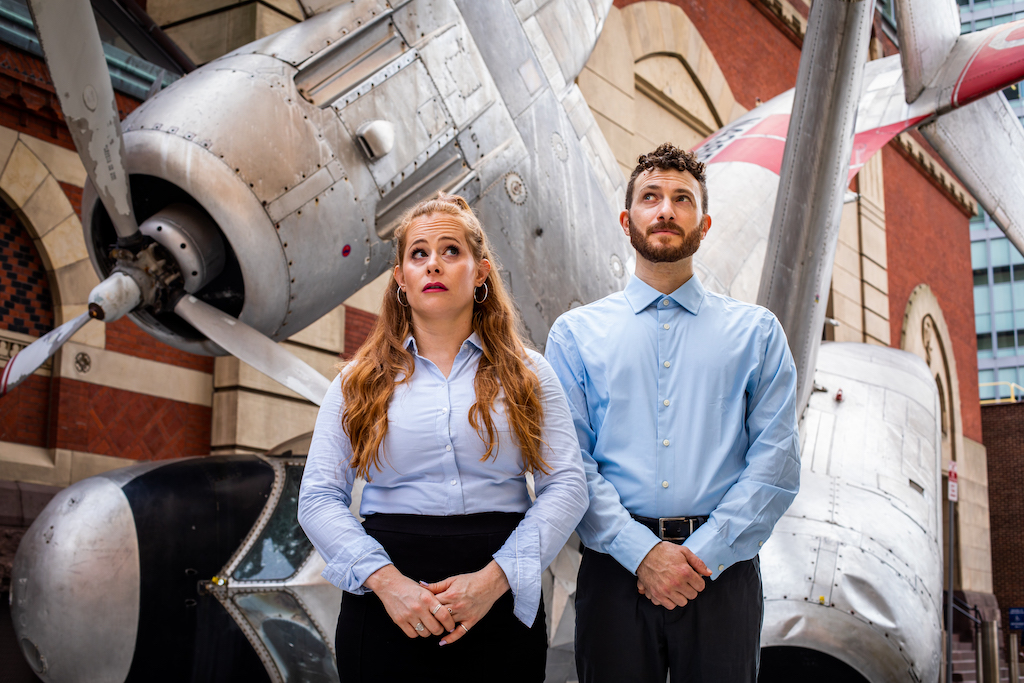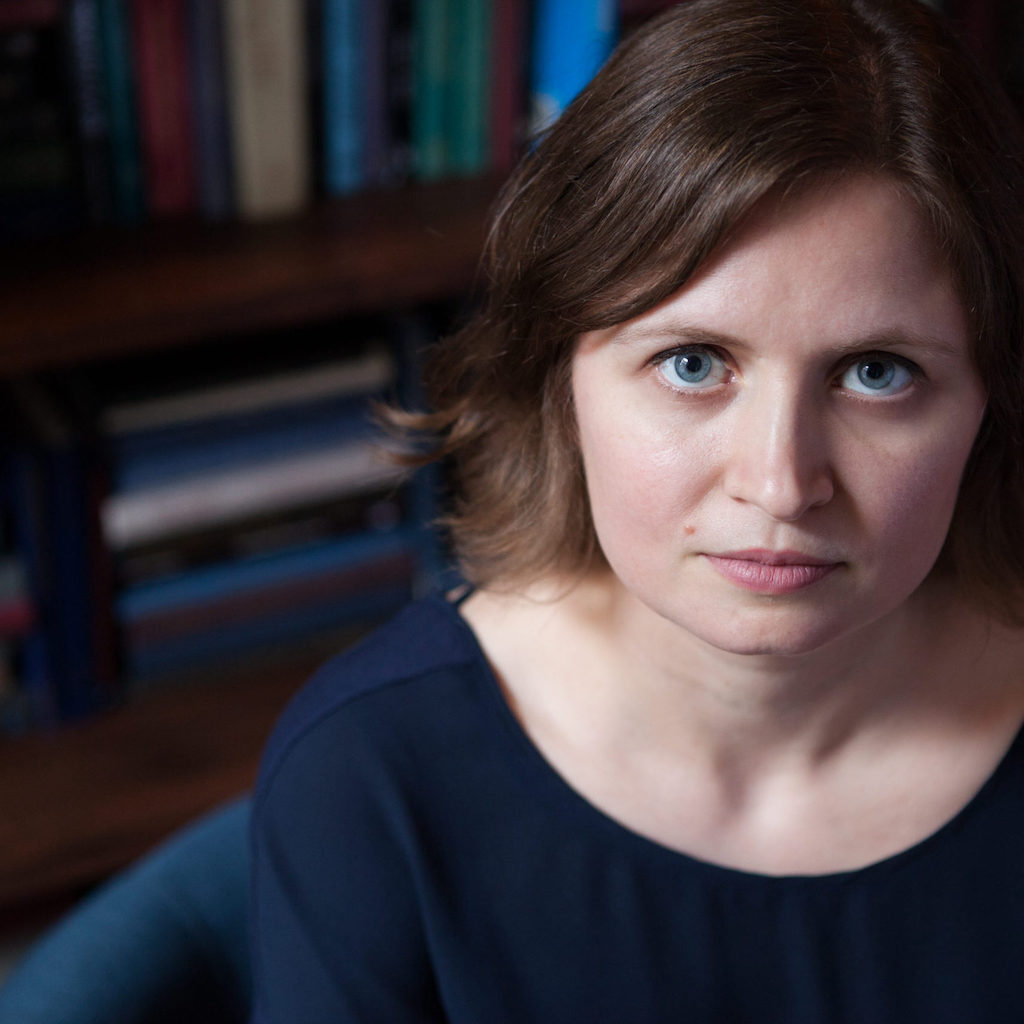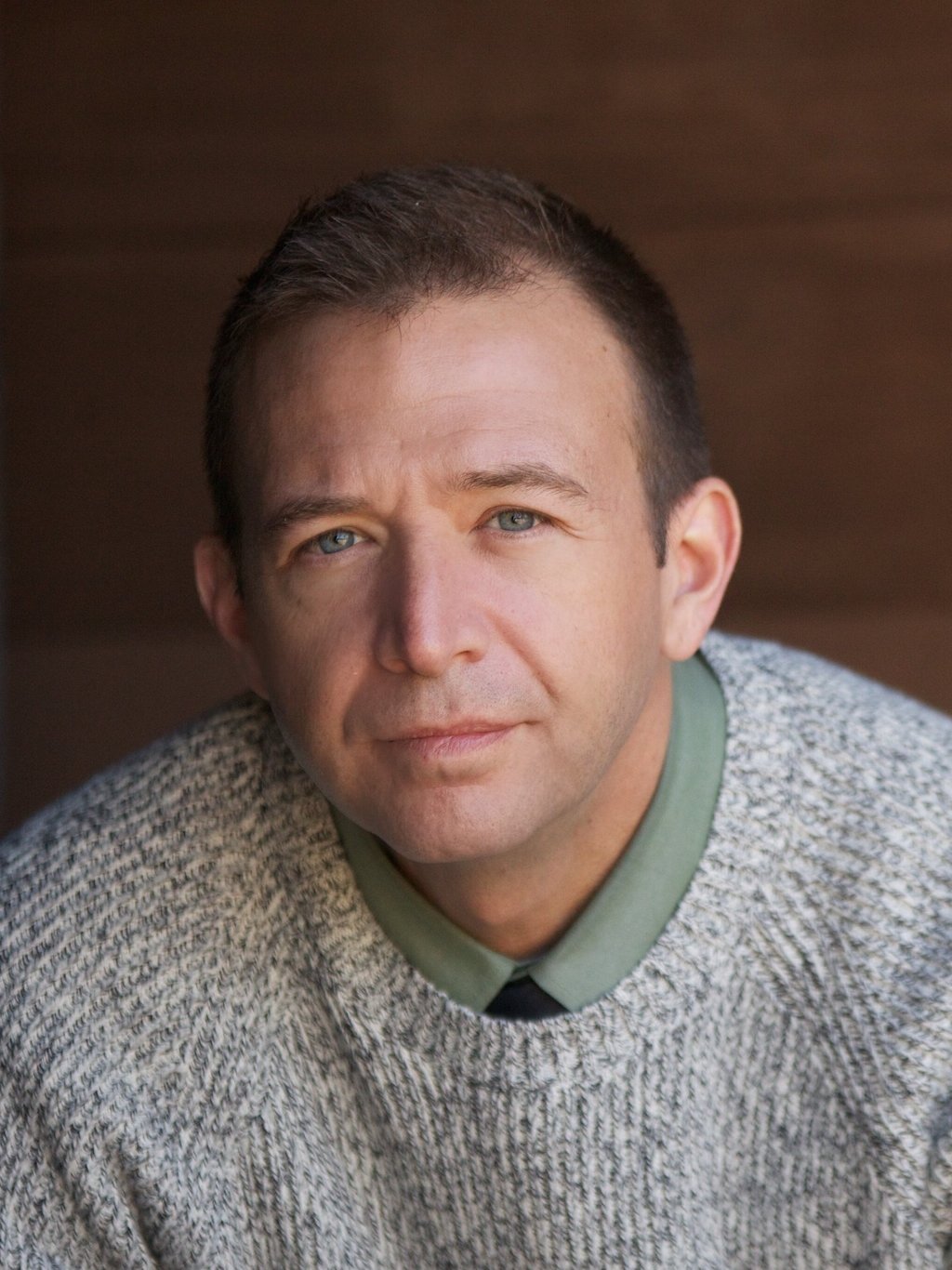
Irish Theater in Philly: “The Weir” at Hedgerow Theatre and Inis Nua’s “A Holy Show” at the Drake.
Several weeks ago, I spoke with Inis Nua Founder and Artistic Director Tom Reing about his first new season’s production back from the pandemic, A Holy Show (penned by up-and coming Irish playwright Janet Moran, running until Oct 24 at The Drake Theater) with its two actors (taking on 20 plus individual roles) Rachel Brodeur and Liam Mulshine.
Together, the threesome discussed the utter spectacle of A Holy Show’s true life comic content, that of a once disgraced Australian monk who hijacked a passenger jet using nothing but blessed holy water.

By this point, everyone in this city and throughout the United States knows well Inis Nua’s rep and dedication to all contemporary theatre Irish, Welsh, Great British and Scottish. In his curation of its mainstage productions, Reing is focused on predominantly gentle and softly spun comedy. “Because we need that right now,” he says. “I wanted to do meaningful plays, but light hearted. I want people to laugh again, even with masks on, to bring joy.”
With that, the Greater Tuna-like display of physical comedy and multiple personalities will be as giddy as they are thought provoking when it comes to A Holy Show.
Across town at the Hedgerow Theatre, and running until October 31, contemporary Irish playwright Conor McPherson’s late-nineties classic The Weir – a dark tall-tale told in a bar in rural Ireland where a mysterious newcomer shocks and thrills the locals – has made as much of a stir as has the Hedgerow’s new Executive Artistic Director Marcie Bramucci showing up has.
The Weir’s director Claire Moyer and one of its actors (and Moyer’s fellow Irish theater expert) Stephen Patrick Smith talk all about their newest work, in two separate interviews below.
Claire Moyer

A.D. Amorosi: Apples and oranges, certainly, but, what does it mean to be the former Associate Director of Inis Nua and now doing or curating in some sense a similar brand of contemporary Irish theater at Hedgerow?
Claire Moyer: My relationship with British and Irish theatre began many years before I started working at Inis Nua and I hope it will continue into the future. I lived and studied theatre in the UK for 4 years, 3 in London, 1 in Glasgow, before moving to Philadelphia and working at Inis Nua felt like a natural continuation. Because of this, this is a niche I have found in my directing in the Philadelphia area and I enjoy that my personal experiences and cultural knowledge allow me to help be a translator between Philadelphia audiences and British and Irish work.
A.D. Amorosi: I have seen a lot of McPherson in my life, up to and including Girl from the North Country. Why do you find his work exemplary within the mod Irish playwrighting continuum, and in particular, why The Weir? What’s so dynamic about The Weir?
Claire Moyer: As we carefully take our first steps back into the theatre, McPherson’s script resonates more profoundly with this moment than I am sure he ever could have predicted. The Weir is a delicate celebration of the need we as humans have for connection. It explores the contrast of community that has been built over generations to those singularly intimate moments that can occur often by accident. It is about the simple act of coming together to tell our stories and that in doing so, we all feel a little less alone. The play is also a study in grief. In this moment we as a nation, as a world, are experiencing a shared communal grief. We have experienced the very real loss of loved ones, but also the loss of a way of life. And this is a play that thrives in the unknown. McPherson let’s his characters believe in fairies, ghosts, god, and the afterlife. He does not pose this as a problem to be solved but rather a truth that we must all learn to live with or even embrace. To tell this story at Hedgerow Theatre, a story haunted with ghosts in a space that has held generations of artists and before them, generations of millworkers, only serves to enhance The Weir. We feel that we are not simply experiencing a moment in time with these characters but that the story we share is just one in a long line of many that have come before and that will come after.
A.D. Amorosi: What is the great dramatic comedic arc in what is, for the most part, a newcomer from Dublin coming to a bar and telling bizarre, intricately connected stories? And how do you cast for that?
Claire Moyer: The Weir has to be handled with a light touch. There are no flashy dramatic moments, but there is suspense, conflict, and heartache. It all just lives in a subtle naturalistic world. It’s a special kind of challenge because you can’t rely on flash… You have to rely on subtle shifts in tone and pacing. As far as casting, it just comes down to finding actors who can handle that and trust the work. Being onstage in a show like this is very vulnerable, There is nothing to hide behind, it’s just you and the words. Working with actors who can handle that is what makes the production click.
A.D. Amorosi: What is the continued challenge and joy of finding and displaying great contemporary Irish theater to American, Philadelphia area audiences not so very acquainted with it all?
Claire Moyer: Many Americans feel an affinity for Ireland, whether that be due to heritage or enjoyment of Irish literature or just the shared English-language culture. I think being able to share contemporary Irish theatre is an opportunity to continue to explore that connection and celebrate it today rather than from out of date or old-fashioned tropes. And when it comes down to it, The Weir is just a beautifully written play with a tenderness and humanity that resonates across countries and cultures.
Stephen Patrick Smith

A.D. Amorosi: I have seen a lot of McPherson in my life, up to and including Girl from the North Country. Why do you find his work exemplary within the mod Irish playwrighting continuum, and in particular, why The Weir? What’s so dynamic about The Weir?
Stephen Patrick Smith: I think there are two qualities to McPherson’s work that make it immediately identifiable to me and give him a unique place in that continuum of Irish playwrights. Firstly, we get to know his characters in extremely intimate detail. I have performed in two of McPherson’s plays, as the title character in The Good Thief and now as Jack in The Weir. Both characters reveal themselves as complex, multi-faceted and flawed individuals over the course of the play. While we may only see the outward personality they prefer to show at first, over the course of the play we see deeper realities. Often these realities are only now being realized by the characters themselves. Like some of Shakespeare’s greatest characters McPherson’s characters, often through long monologues, invent or re-invent themselves in front of our eyes, which can be fascinating to an audience and a rewarding challenge for an actor. Because we come to know these characters so well, the audience feels part of the community of characters on the stage or connected to the experience of the character in the case of a one-person monologue like The Good Thief. If catharsis is still a powerful benefit of the theatrical experience, in the feeling of release from empathizing with other people and the comfort of knowing we are not alone in our experiences of joy, tragedy, friendship and loss, then McPherson’s plays reward an audience with that catharsis as they come to know these characters and their relationships so intimately. The Weir is particularly effective at this as we are welcomed into a pub, a place where years-long relationships are established, and we are admitted into those relationships. We come to know each of the characters in ever increasing detail, their losses, loves and fears, through long stories. In these times of isolation, whether self-inflicted through our obsession with our devices and social media or enforced by the COVID pandemic, plays like this can be a powerful way to remind us of the importance of the communal experience, of getting to know someone by being in the same space as them and sharing stories. It can remind us that a life is not just the snapshots of our highs and lows that we see in social media, an experience I find more alienating than communal. The other thing that McPherson taps into that makes his plays unique is the infusion of the supernatural, whether overtly or glimmering just outside our perception of the action but sensed all the same. He has a sense, as I think many Irish do, of the cultural insecurities and inchoate dread that can be specifically Irish but are also held in common with all cultures. He has a respect but also a wariness for the stories we have told ourselves to explain the inexplicable or justify our prejudices and insecurities. These can be fairy tales and ghost stories but also Biblical traditions and superstitions. Or they can simply be an indefinable awareness of parallel occurrences and coincidences that suggest some outer, unknown force is at work. This quality of his work again contributes to that sense of catharsis as an audience recognizes these universal tropes embedded in the superstitions of the characters on the stage. As I’ve stated, McPherson’s plays often rely very heavily on long story-monologues. These would not be as effective as they are without McPherson’s knack for writing in the vernacular, which also invites us into a character’s unique world and personality. He has an ear for the particular rhythms and hesitancies of the Irish speaker, the turns of phrase and the hems and haws. This is what I find immensely helpful as an actor in communicating through the lines these finely detailed personalities.
A.D. Amorosi: What is the great dramatic and comedic arc in what is, for the most part, newcomer from Dublin coming to a bar and telling bizarre, intricately connected stories? And how do you find the drama for that?
Stephen Patrick Smith: For me, the arc is in the sequence of stories. Most of the stories are fairy tales or ghost stories, types of stories which in many cultures traditionally have been used to give meaning to what seems like senseless or arbitrary loss or tragedy. Each story is told by a different character, and all of the characters in the play are damaged and lonely in some way. The telling of such stories can be beneficial in the sense that it can provide comfort to people suffering loss, but it can also be detrimental in that it can create denial and a refusal to look at the real causes of tragedy and possible ways of coping with it. The stakes get a little higher with each story. The first two are fairly harmless, spooky stories that give a sense of the history of the community and perhaps explain a certain loss of innocence on the storyteller’s part. But then we get a ghost story in which the ghost seems to have been a pedophile and a sexual predator in life. The next story concerns a mother dealing with the devastating effects of the accidental death of her young child. The listeners, in the play and presumably in the audience, are far more disturbed by these stories than the first two. Is it appropriate to conceal or avoid these types of realities with supernatural explanations? Can the stories that we use to comfort ourselves have devastating effects all their own? As Finbar says, “That’s what these stories do.” In the end, we are given a final story from Jack about loss and loneliness which has no supernatural elements to it. Jack admits his own responsibility in the loss of what could have been a real meaningful relationship in his life rather than the life he has lived as an aging bachelor on his own. He may not understand his younger self and the actions he took or didn’t take but he realizes they were all his own actions. He also recognizes, perhaps too late, the comfort that can be found not from the supernatural, but from the connection to another human being, even a stranger, through a gesture as simple as having someone make you a sandwich. I think the drama lies in that conflict between the avoidance of reality in the supernatural, and the confronting and acceptance of reality and the fact that life is sometimes mysterious and messy and our actions are opaque even to ourselves. Interestingly, I think this conflict resonates even more today than when the play was written, as we find ourselves astonishingly arguing over what “facts” are and preferring conspiracy theories and preposterous myths over science.
A.D. Amorosi: What is the continued challenge and joy of finding and displaying great contemporary Irish theater to an American Philadelphia area audience not so very acquainted with it all?
Stephen Patrick Smith: The Irish have always been regarded as great storytellers. Everyone loves a good story. I think the challenge is in getting a potential audience to look past the “Irish” label and come to the theatre to see a story which will be about our common humanity and touch on universal themes that we all can recognize no matter the culture we were born into or live in now. It is simply told in an Irish accent. I recognize that the Irish are probably over-represented as a culture in the theatre and I would hope that those that are less represented get the same opportunities to be produced. I do think that the Irish have a prominent spot in the theatrical canon because they have a particular feel for combining the tragic and the comic and recognizing that both enhance the other. One of my favorite quotes about the Irish is from the poet W.B. Yeats. He wrote, “Being Irish, he had an abiding sense of tragedy which sustained him through temporary periods of joy.” I think that combination of a celebration of life with the acknowledgment that there will always be a disconcerting sense of dread is what audiences are drawn to in Irish plays. You see it in Conor McPherson and Martin McDonagh, who inherited it from Synge and Beckett and O’Casey. And again, it is even more resonant today, as we try to find joy and meaning in the midst of climate change and political rancor and a global pandemic. The Irish playwrights and plays like The Weir give a chance to connect to other humans and realize we are more alike than some would have us believe. We are happy to be alive, but there is also that insecurity that might be behind us if we dare turn around, or that tragedy around the next corner, and we’d rather not face it alone.


About Post Author
Discover more from dosage MAGAZINE
Subscribe to get the latest posts sent to your email.

